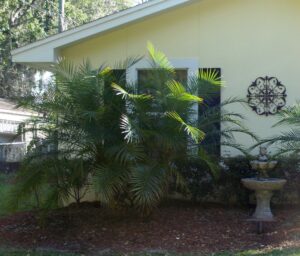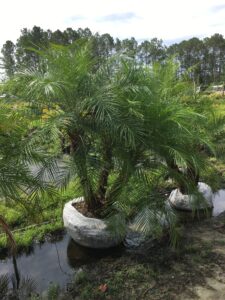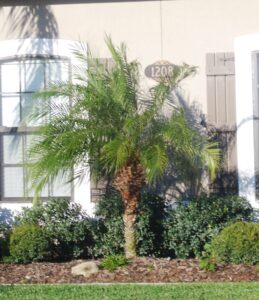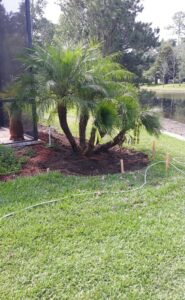Pygmy Date Palm
( Phoenix Roebelenii Palm )
 Pygmy Date Palm / Phoenix Roebelenii Palm Origins:
Pygmy Date Palm / Phoenix Roebelenii Palm Origins:
-Pygmy Date Palm / Phoenix Roebelenii Palm Origins is native to Laos where it can be found growing along the banks of the Mekong River. It makes an excellent potted palm in colder climate zones and does well in frost free areas of our North Florida landscape.
– Plant these palms as understory plants under larger native Oaks and
Maples or o tea South side of the house and where fences, etc. protect them from harsh north winter winds.
– In the more frost free areas of our North Florida / Jacksonville / St.
Augustine area commercial and residential landscapes palms may not suffer any winter damage at all and can be planted and maintained with no winter protection needed. ( Plant may suffer frond damage in more frost prone areas of Northern Florida but will acclimate itself into its new home and become hardier through the years.)
Pygmy Date Palm / Phoenix Roebelenii Palm  Preferred Exposure:
Preferred Exposure:
– Full sun or full shade, even tolerates indoor applications in bright
light.
Pygmy Date Palm / Phoenix Roebelenii Palm Fronds | Trunk:
– Widely cultivated member of the Phoenix family of palms for its highly decorative foliage, deep green fernlike fronds have a gentle arching form and are numerous on the palm creating an instantly lush tropical garden in any planting location.
– Foliage of the Pygmy Date Palm / Phoenix Roebelenii Palm remains evergreen through the winter in the North Florida landscape. ( Plant may suffer frond damage in more frost prone areas of Northern Florida but will acclimate itself into its new home and become hardier through the years.) palm fronds have sharp need like unopened leaves close to the trunk on branches.
– Pygmy Date Palm / Phoenix Roebelenii Palms have extremely slender ( only a few inches across) single or multiple trunks, palm trunks are
highly textured and add to the palms overall appeal.
Pygmy Date Palm / Phoenix Roebelenii Palm Soil Preference / Salt
tolerance:
– Pygmy Date Palm / Phoenix Roebelenii Palms planted in the North
Florida | Jacksonville | St. Augustine landscape will tolerate virtually any soil components, and tolerate moist to well draining dryer soils.
– Lower salt tolerance, avoid plantings directly on ocean side of coastal
areas, inland plantings fare well.
Pygmy Date Palm / Phoenix Roebelenii Size Variance:
– Pygmy Date Palm / Phoenix Roebelenii are very slow growing
and only reach sizes of 12-15 feet H | and spreading 6-10 feet in width. Often seen at only 6-10 ft in the North Florida landscape.
Pygmy Date Palm / Phoenix Roebelenii Growth Habit:
– Pygmy Date Palm / Phoenix Roebelenii palms have highly decorative foliage and fronds form a broad full crown with gracefully arching foliage that tends to weep slightly downwards with a gently arching habit.
Pygmy Date Palm / Phoenix  Roebelenii Palm Growth Rate:
Roebelenii Palm Growth Rate:
– These dwarf members of the Phoenix family can be expected to grow only a few inches each year even with ideal landscape conditions and care.
Pygmy Date Palm / Phoenix Roebelenii Palm Bloom:
– Yellowed white flower clusters are quite showy in large draping clusters
hanging down between branches, but shot lived.
Pygmy Date Palm / Phoenix Roebelenii Palm Water Requirements:
– Moderately drought tolerant once established into the landscape. Take care to water your Pygmy Date Palm / Phoenix Roebelenii Palm well for the first few months after being planted from and S & J Nursery container into the landscape.
– Pygmy Date Palm / Phoenix Roebelenii Palm respond well to supplemental irrigation and fertilizer treatments.
Best Uses For Pygmy Date Palm / Phoenix  Roebelenii Palm in the North Florida | Jacksonville | St. Augustine area landscape:
Roebelenii Palm in the North Florida | Jacksonville | St. Augustine area landscape:
– Pygmy Date Palm / Phoenix Roebelenii Palm are an excellent choice
for a landscape statement for smaller frontage more modern yards and gardens or commercial buildings where their highly decorative heads can be fully appreciated as a focal accent of the landscape.
– Soft root systems allow palms to be planted near house foundations,
patios, walkways and other hardscape with no damage to the tree or the paved areas.
– These small scale palm trees are the perfect choice near pools and
patio areas where larger palms would interfere with walk space and make excellent potted palms indoors or out in the landscape.
Care of Pygmy Date Palm / Phoenix Roebelenii Palm:
– Pygmy Date Palm / Phoenix Roebelenii Palm will need good water during
the establishment period and are moderately drought tolerant once established into the landscape.
– Pygmy Date Palm / Phoenix Roebelenii Palm respond well to
supplemental irrigation and fertilizer treatments.
– Fertilize each fall generously with magnesium sulfate and palm food to ensure your palm goes into the winter season as healthy as possible.
– Minimal pruning is required to keep these palms looking their best, trim off old browned out palm fronds each year in early spring or as needed.
MINIMUM PALM FERTILIZER REGIMEN – what you should be doing to keep your palm healthy
– Fertilize each spring with a specially blended fertilizer for Palms, follow
manufacturers directions and apply 1/2 lb o 1lb of fertilizer per inch of diameter of trunk on your palm, measured from a hands width above the ground level. That means for a 12 inch wide trunk from left to right you
would need 6-12 lbs of fertilizer for just that one palm!
– Fertilize every fall with magnesium sulfate ( Epsom Salt) to keep your palm green and healthy through the winter months!
MAXIMUM PALM FERTILIZER REGIMEN – what you can do to get your palm up and growing
Fast!
– Fertilize every three months with your choice of Palm fertilizer and
Magnesium Sulfate. Water 3-4 times per week and make sure to water thoroughly after each fertilizer application.
– Wait till fronds have turned completely brown before removing from the palm as the palm will take back in the nutrients from those older leaves ad use it when forming new ones.
*CAUTION – DO NOT FERTILIZE NEWLY PLANTED
/ TRANSPLANTED
FIELD GROWN PALM TREES WITH PALM
FOOD!
Note : When planting smaller palms being grown in a container, this rule does not apply, rather, use half the recommended application rate for your trunks diameter, as containered palms roots have not been damaged or cut during planting but are still only a portion as large as they would be if the palm had been growing in the ground and excess fertilizer on a confined root system is still not preferable for maximum health.
Palm fertilizers are water soluble and will burn the new roots your palm tree is trying to put out as it establishes itself into the landscape. It is best to use only poly coated plant food that is heat release like Osmocote general purpose fertilizer or non burning Milorganite in the first year in the landscape, and then the following year, start your palm food regimen that will provide all of the minor nutrients that your palms will need to keep them healthy and problem free in Florida’s soils.

